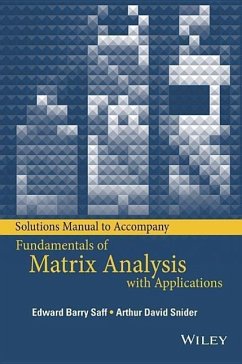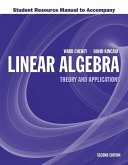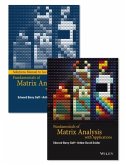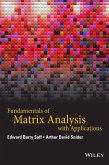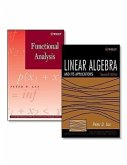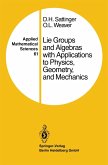Edward Barry Saff, Arthur David Snider
Solutions Manual to Accompany Fundamentals of Matrix Analysis with Applications
Edward Barry Saff, Arthur David Snider
Solutions Manual to Accompany Fundamentals of Matrix Analysis with Applications
- Broschiertes Buch
- Merkliste
- Auf die Merkliste
- Bewerten Bewerten
- Teilen
- Produkt teilen
- Produkterinnerung
- Produkterinnerung
Solutions Manual to accompany Fundamentals of Matrix Analysis with Applications--an accessible and clear introduction to linear algebra with a focus on matrices and engineering applications.
Andere Kunden interessierten sich auch für
![Student Resource Manual to Accompany Linear Algebra: Theory and Application Student Resource Manual to Accompany Linear Algebra: Theory and Application]() Ward CheneyStudent Resource Manual to Accompany Linear Algebra: Theory and Application69,99 €
Ward CheneyStudent Resource Manual to Accompany Linear Algebra: Theory and Application69,99 €![Fundamentals of Matrix Analysis with Applications Set Fundamentals of Matrix Analysis with Applications Set]() Edward Barry SaffFundamentals of Matrix Analysis with Applications Set146,99 €
Edward Barry SaffFundamentals of Matrix Analysis with Applications Set146,99 €![Fundamentals of Matrix Analysis with Applications Fundamentals of Matrix Analysis with Applications]() Edward B. SaffFundamentals of Matrix Analysis with Applications124,99 €
Edward B. SaffFundamentals of Matrix Analysis with Applications124,99 €![A Complete Algebra to Accompany Ray's Series of Mathematics A Complete Algebra to Accompany Ray's Series of Mathematics]() George W SmithA Complete Algebra to Accompany Ray's Series of Mathematics40,99 €
George W SmithA Complete Algebra to Accompany Ray's Series of Mathematics40,99 €![Linear Algebra and Its Applications, 2e + Functional Analysis Set Linear Algebra and Its Applications, 2e + Functional Analysis Set]() Peter D LaxLinear Algebra and Its Applications, 2e + Functional Analysis Set239,99 €
Peter D LaxLinear Algebra and Its Applications, 2e + Functional Analysis Set239,99 €![Spatiotemporal Data Analysis Spatiotemporal Data Analysis]() Gidon EshelSpatiotemporal Data Analysis137,99 €
Gidon EshelSpatiotemporal Data Analysis137,99 €![Lie Groups and Algebras with Applications to Physics, Geometry, and Mechanics Lie Groups and Algebras with Applications to Physics, Geometry, and Mechanics]() D H SattingerLie Groups and Algebras with Applications to Physics, Geometry, and Mechanics146,99 €
D H SattingerLie Groups and Algebras with Applications to Physics, Geometry, and Mechanics146,99 €-
-
-
Solutions Manual to accompany Fundamentals of Matrix Analysis with Applications--an accessible and clear introduction to linear algebra with a focus on matrices and engineering applications.
Hinweis: Dieser Artikel kann nur an eine deutsche Lieferadresse ausgeliefert werden.
Hinweis: Dieser Artikel kann nur an eine deutsche Lieferadresse ausgeliefert werden.
Produktdetails
- Produktdetails
- Verlag: Wiley
- Seitenzahl: 268
- Erscheinungstermin: 15. Februar 2016
- Englisch
- Abmessung: 226mm x 152mm x 18mm
- Gewicht: 386g
- ISBN-13: 9781118996324
- ISBN-10: 1118996321
- Artikelnr.: 41754380
- Herstellerkennzeichnung
- Libri GmbH
- Europaallee 1
- 36244 Bad Hersfeld
- gpsr@libri.de
- Verlag: Wiley
- Seitenzahl: 268
- Erscheinungstermin: 15. Februar 2016
- Englisch
- Abmessung: 226mm x 152mm x 18mm
- Gewicht: 386g
- ISBN-13: 9781118996324
- ISBN-10: 1118996321
- Artikelnr.: 41754380
- Herstellerkennzeichnung
- Libri GmbH
- Europaallee 1
- 36244 Bad Hersfeld
- gpsr@libri.de
Edward Barry Saff, PhD, is Professor of Mathematics and Director of the Center for Constructive Approximation at Vanderbilt University. Dr. Saff is an Inaugural Fellow of the American Mathematical Society, Foreign Member of the Bulgarian Academy of Science, and the recipient of both a Guggenheim and Fulbright Fellowship. He is Editor-in-Chief of two research journals, Constructive Approximation and Computational Methods and Function Theory, and has authored or coauthored over 250 journal articles and eight books. Dr. Saff also serves as an organizer for a sequence of international research conferences that help to foster the careers of mathematicians from developing countries. Arthur Da vid Snider, PhD, PE, is Professor Emeritus at the University of South Florida, where he served on the faculties of the Departments of Mathematics, Physics, and Electrical Engineering. Previously an analyst at the Massachusetts Institute of Technology's Draper Lab and recipient of the USF Krivanek Distinguished Teacher Award, he consults in industry and has authored or coauthored over 100 journal articles and eight books. With the support of the National Science Foundation, Dr. Snider also pioneered a course in fine art appreciation for engineers.
1 Systems of Linear Algebraic Equations 1
1.1 Linear Algebraic Equations 1
1.2 Matrix Representation of Linear Systems and the Gauss-Jordan Algorithm
12
1.3 The Complete Gauss Elimination Algorithm 17
1.4 Echelon Form and Rank 26
1.5 Computational Considerations 34
2 Matrix Algebra 39
2.1 Matrix Multiplication 39
2.2 Some Useful Applications of Matrix Operators 48
2.3 The Inverse and the Transpose 54
2.4 Determinants 61
2.5 Three Important Determinant Rules 68
PART I REVIEW PROBLEMS FOR PART I 79
3 Vector Spaces 89
3.1 General Spaces, Subspaces, and Spans 89
3.2 Linear Dependence 93
3.3 Bases, Dimension, and Rank 97
4 Orthogonality 105
4.1 Orthogonal Vectors and the Gram-Schmidt Algorithm 105
4.2 Orthogonal Matrices 115
4.3 Least Squares 123
4.4 Function Spaces 133
PART II REVIEW PROBLEMS FOR PART II 140
5 Eigenvectors and Eigenvalues 144
5.1 Eigenvector Basics 144
5.2 Calculating Eigenvalues and Eigenvectors 155
5.3 Symmetric and Hermitian Matrices 168
6 Similarity 181
6.1 Similarity Transformations and Diagonalizability 181
6.2 Principal Axes and Normal Modes 189
6.3 Schur Decomposition and Its Implications 198
6.4 The Singular Value Decomposition 212
6.5 The Power Method and the QR Algorithm 217
7 Linear Systems of Differential Equations 221
7.1 First-Order Linear Systems 221
7.2 The Matrix Exponential Function 230
7.3 The Jordan Normal Form 236
7.4 Matrix Exponentiation via Generalized Eigenvectors 246
PART III REVIEW PROBLEMS FOR PART III 255
1.1 Linear Algebraic Equations 1
1.2 Matrix Representation of Linear Systems and the Gauss-Jordan Algorithm
12
1.3 The Complete Gauss Elimination Algorithm 17
1.4 Echelon Form and Rank 26
1.5 Computational Considerations 34
2 Matrix Algebra 39
2.1 Matrix Multiplication 39
2.2 Some Useful Applications of Matrix Operators 48
2.3 The Inverse and the Transpose 54
2.4 Determinants 61
2.5 Three Important Determinant Rules 68
PART I REVIEW PROBLEMS FOR PART I 79
3 Vector Spaces 89
3.1 General Spaces, Subspaces, and Spans 89
3.2 Linear Dependence 93
3.3 Bases, Dimension, and Rank 97
4 Orthogonality 105
4.1 Orthogonal Vectors and the Gram-Schmidt Algorithm 105
4.2 Orthogonal Matrices 115
4.3 Least Squares 123
4.4 Function Spaces 133
PART II REVIEW PROBLEMS FOR PART II 140
5 Eigenvectors and Eigenvalues 144
5.1 Eigenvector Basics 144
5.2 Calculating Eigenvalues and Eigenvectors 155
5.3 Symmetric and Hermitian Matrices 168
6 Similarity 181
6.1 Similarity Transformations and Diagonalizability 181
6.2 Principal Axes and Normal Modes 189
6.3 Schur Decomposition and Its Implications 198
6.4 The Singular Value Decomposition 212
6.5 The Power Method and the QR Algorithm 217
7 Linear Systems of Differential Equations 221
7.1 First-Order Linear Systems 221
7.2 The Matrix Exponential Function 230
7.3 The Jordan Normal Form 236
7.4 Matrix Exponentiation via Generalized Eigenvectors 246
PART III REVIEW PROBLEMS FOR PART III 255
1 Systems of Linear Algebraic Equations 1
1.1 Linear Algebraic Equations 1
1.2 Matrix Representation of Linear Systems and the Gauss-Jordan Algorithm
12
1.3 The Complete Gauss Elimination Algorithm 17
1.4 Echelon Form and Rank 26
1.5 Computational Considerations 34
2 Matrix Algebra 39
2.1 Matrix Multiplication 39
2.2 Some Useful Applications of Matrix Operators 48
2.3 The Inverse and the Transpose 54
2.4 Determinants 61
2.5 Three Important Determinant Rules 68
PART I REVIEW PROBLEMS FOR PART I 79
3 Vector Spaces 89
3.1 General Spaces, Subspaces, and Spans 89
3.2 Linear Dependence 93
3.3 Bases, Dimension, and Rank 97
4 Orthogonality 105
4.1 Orthogonal Vectors and the Gram-Schmidt Algorithm 105
4.2 Orthogonal Matrices 115
4.3 Least Squares 123
4.4 Function Spaces 133
PART II REVIEW PROBLEMS FOR PART II 140
5 Eigenvectors and Eigenvalues 144
5.1 Eigenvector Basics 144
5.2 Calculating Eigenvalues and Eigenvectors 155
5.3 Symmetric and Hermitian Matrices 168
6 Similarity 181
6.1 Similarity Transformations and Diagonalizability 181
6.2 Principal Axes and Normal Modes 189
6.3 Schur Decomposition and Its Implications 198
6.4 The Singular Value Decomposition 212
6.5 The Power Method and the QR Algorithm 217
7 Linear Systems of Differential Equations 221
7.1 First-Order Linear Systems 221
7.2 The Matrix Exponential Function 230
7.3 The Jordan Normal Form 236
7.4 Matrix Exponentiation via Generalized Eigenvectors 246
PART III REVIEW PROBLEMS FOR PART III 255
1.1 Linear Algebraic Equations 1
1.2 Matrix Representation of Linear Systems and the Gauss-Jordan Algorithm
12
1.3 The Complete Gauss Elimination Algorithm 17
1.4 Echelon Form and Rank 26
1.5 Computational Considerations 34
2 Matrix Algebra 39
2.1 Matrix Multiplication 39
2.2 Some Useful Applications of Matrix Operators 48
2.3 The Inverse and the Transpose 54
2.4 Determinants 61
2.5 Three Important Determinant Rules 68
PART I REVIEW PROBLEMS FOR PART I 79
3 Vector Spaces 89
3.1 General Spaces, Subspaces, and Spans 89
3.2 Linear Dependence 93
3.3 Bases, Dimension, and Rank 97
4 Orthogonality 105
4.1 Orthogonal Vectors and the Gram-Schmidt Algorithm 105
4.2 Orthogonal Matrices 115
4.3 Least Squares 123
4.4 Function Spaces 133
PART II REVIEW PROBLEMS FOR PART II 140
5 Eigenvectors and Eigenvalues 144
5.1 Eigenvector Basics 144
5.2 Calculating Eigenvalues and Eigenvectors 155
5.3 Symmetric and Hermitian Matrices 168
6 Similarity 181
6.1 Similarity Transformations and Diagonalizability 181
6.2 Principal Axes and Normal Modes 189
6.3 Schur Decomposition and Its Implications 198
6.4 The Singular Value Decomposition 212
6.5 The Power Method and the QR Algorithm 217
7 Linear Systems of Differential Equations 221
7.1 First-Order Linear Systems 221
7.2 The Matrix Exponential Function 230
7.3 The Jordan Normal Form 236
7.4 Matrix Exponentiation via Generalized Eigenvectors 246
PART III REVIEW PROBLEMS FOR PART III 255

